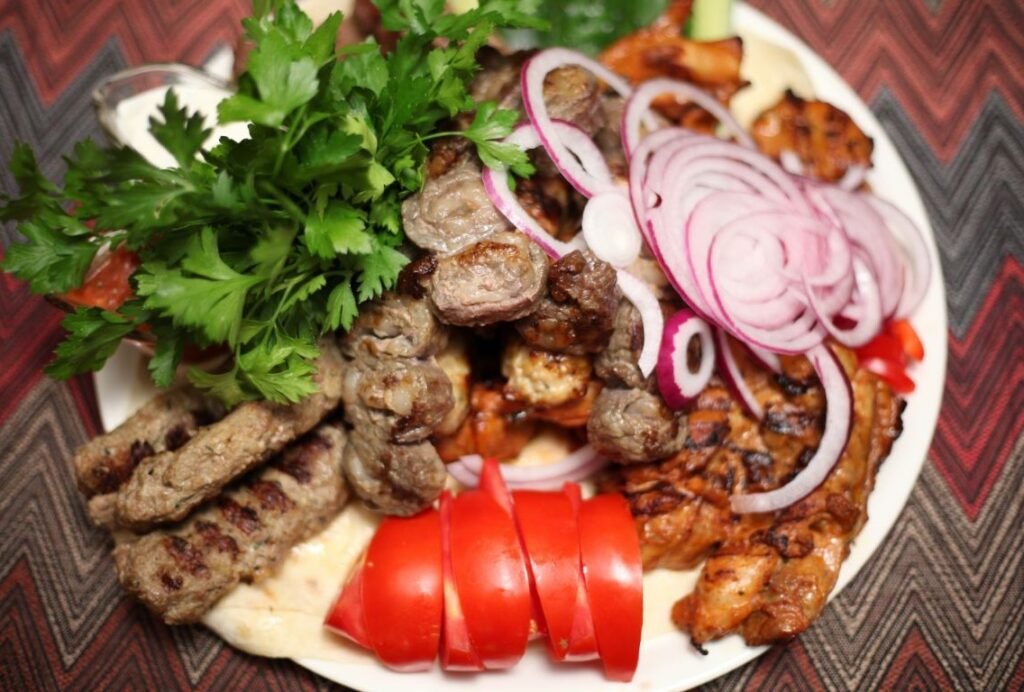Introduction to Kebabs
Kebabs are a diverse and richly flavored culinary offering that has transcended borders and cultures throughout history. These skewered meats, typically grilled or roasted, often serve as a delightful centerpiece in many cuisines around the world. The term “kebab” generally refers to various cooking methods involving meat, which can be accompanied by vegetables, sauces, and spices. The variety of kebabs is vast, ranging from the tender shish kebabs of Middle Eastern cuisine to the spiced seekh kebabs of South Asia.
The origins of kebabs can be traced back to ancient civilizations, where the practice of cooking meat on skewers was popular among nomadic tribes. Historical accounts suggest that these early kebabs were often made with locally available ingredients, which influenced their flavors and presentation. Over time, as trade routes expanded and cultures interacted, kebab cooking techniques and recipes evolved, contributing to the vast array of kebabs we know today.
Culturally, kebabs hold significant importance in many regions. In countries like Turkey and Iran, they are not only popular street food but also an integral part of celebratory meals, signifying hospitality and festivity. In India, the kebab recipe has been adapted to local tastes, often featuring rich spices and herbs, creating a unique twist that resonates with regional palettes. Furthermore, kebabs have also gained international fame; they are celebrated worldwide for their versatility and the opportunity they provide for culinary creativity.
In essence, kebabs are not merely a dish; they represent a culinary experience that reflects the heritage of the regions from which they originate. Each kebab tells a story of culture, history, and the love of good food, allowing people to enjoy flavors that span across continents and generations.
Types of Kebabs Around the World

Kebabs are a diverse category of dishes that have taken on various forms across different cultures and regions, each with its unique flavors, ingredients, and cooking techniques. One of the most recognized types is the Shish Kebab, which originates from the Middle East. Typically made with marinated chunks of meat, such as lamb or chicken, skewered with vegetables, Shish Kebabs are grilled to perfection over an open flame, allowing the juices to infuse the meat, resulting in a tender and flavorful dish.
Another popular variety is the Seekh Kebab, which is particularly favored in South Asian cuisine. This type of kebab is made with minced meat, often lamb or beef, mixed with spices, and then molded onto skewers. Cooked in a tandoor or on a grill, Seekh Kebabs are distinctive for their spiced flavor and soft texture. They are often served with naan or chutney, making for a delightful meal.
The Doner Kebab is an iconic street food that hails from Turkey, characterized by its vertical rotisserie cooking method. Thin slices of marinated meat, usually lamb, chicken, or beef, are stacked in a cone shape on a spit. As the outer layer cooks, it is shaved off and served in pita bread or on a platter, accompanied by vegetables and sauces. This method not only cooks the meat evenly but also enhances its flavor profile.
Lastly, Satay brings a taste of Southeast Asia to the kebab family. Made with skewered and grilled marinated meat, such as chicken or beef, Satay is often served with a rich peanut sauce. The cooking technique involves using high heat to achieve a charred exterior while keeping the inside juicy, offering a delightful combination of textures and flavors.
These various types of kebabs reflect the rich culinary traditions found around the world, each presenting its unique characteristics that cater to diverse palates and preferences.
Essential Ingredients for Kebab Recipes

When it comes to crafting delicious kebab recipes, the quality and selection of ingredients play a crucial role. Traditionally, kebabs consist of marinated meats, which serve as the foundation for this beloved dish. Commonly used meats include lamb, chicken, beef, and even seafood. The choice of meat can greatly influence the overall flavor and texture of the kebab, making it essential to select high-quality cuts. For instance, using tender portions of meat like leg of lamb or chicken thighs not only enhances the taste but also ensures that the kebabs remain juicy when cooked.
The marinade is another fundamental component that can elevate a kebab recipe. A typical marinade may include yogurt or oil, citrus juices, garlic, and an array of spices such as cumin, coriander, and paprika. These ingredients impart depth and complexity to the meat, allowing the spices to meld with the natural flavors. Additionally, the marination process tenderizes the meat, making it more succulent. For those seeking variations, vegetarian and vegan kebabs are delightful alternatives. Ingredients such as mushrooms, tofu, paneer, and various vegetables can be marinated and grilled, creating satisfying plant-based kebabs.
Moreover, spices play a pivotal role in defining the character of the kebab. From the smoky depth of paprika to the warmth of cumin, these aromatics are often blended to create a distinct flavor profile. Fresh herbs like cilantro or parsley may also be incorporated for an added burst of freshness. The inclusion of vegetables, such as bell peppers, onions, and zucchini, not only adds color but also enhances the nutritional value of the kebabs. Ultimately, selecting the right ingredients and focusing on quality are key to achieving the perfect kebab, whether it is a meat-based or vegetarian alternative. This attention to detail can turn a simple kebab recipe into a memorable culinary experience.
Step-by-Step Guide to Making Classic Shish Kebab

Preparing classic Shish Kebab is a delightful culinary endeavor that allows you to indulge in a variety of flavors and textures. To start, gather your ingredients. You will need cubed pieces of meat, typically lamb, beef, or chicken, alongside vibrant vegetables such as bell peppers, onions, and cherry tomatoes. For a more authentic kebab experience, focus on using fresh, high-quality ingredients.
The marination process is crucial for enhancing the flavor of your kebabs. For a classic marinade, combine olive oil, minced garlic, lemon juice, ground cumin, salt, and pepper. This mixture infuses the meat with aromatic flavors while also tenderizing it. Allow the cubed meat to marinate for at least 2-4 hours, although an overnight marination yields even better results. During this time, the acid in the lemon juice will work wonders on the meat’s texture and taste.
Once marinated, it’s time to prepare the skewers. Soak bamboo skewers in water for about 30 minutes to prevent them from burning on the grill. Alternatively, metal skewers can be used for a more durable option. For assembly, thread the marinated meat onto the skewer, interspersing it with vibrant pieces of vegetables. This not only enhances the presentation but also allows the veggies to absorb the delicious flavors of the kebab during cooking.
Grilling the kebabs is the final and crucial step. Preheat your grill to medium-high heat. Place the skewers on the grill, ensuring they are not overcrowded, which can lead to uneven cooking. Cook the kebabs for about 10-15 minutes, turning them occasionally to achieve an even char. Use a meat thermometer to check for doneness; chicken should reach an internal temperature of 165°F, while beef or lamb should be cooked to your preferred doneness level. The result will be succulent, flavorful Shish Kebabs that are sure to impress your guests.
Delicious Marinades for Juicy Kebabs
One of the most significant aspects of preparing succulent kebabs lies in the marinades used to enhance their flavor and tenderness. Marinades are mixtures of acidic and flavorful ingredients that penetrate the meat or vegetables, breaking down fibers and imparting delicious flavors. Below, we explore various traditional and innovative kebab marinade recipes that cater to different types of meats and vegetarian options.
For a classic approach, a yogurt-based marinade is a popular choice, especially for chicken kebabs. Combining plain yogurt, lemon juice, minced garlic, cumin, coriander, and salt creates a rich, tangy mixture that tenderizes the chicken while adding aromatic flavors. Let the chicken marinate for at least two hours, although overnight will yield even more delightful results.
For lamb kebabs, a marinade that incorporates olive oil, red wine vinegar, rosemary, thyme, and garlic works wonders. The acidity from the vinegar helps to soften the meat, allowing the spices to penetrate deeper, infusing it with robust flavors. A minimum marinating time of four hours, or ideally overnight, is recommended for optimal taste.
Vegetarians can also delight in marinades that enhance kebabs made from vegetables or plant-based proteins. A zesty marinade of balsamic vinegar, Dijon mustard, garlic, and honey is excellent for mushroom or bell pepper skewers. This combination not only adds depth but also keeps the vegetables moist during grilling. A marinating period of at least 30 minutes can be sufficient for vegetables.
In addition to these traditional recipes, creativity in combining ingredients such as coconut milk with turmeric and ginger is gaining traction. This combination is particularly favorable for seafood kebabs, yielding a sweet and spicy flavor profile. It is essential to marinate seafood for no more than an hour to prevent the meat from becoming mushy.
Choosing the right marinade based on the type of kebab being prepared is crucial. Whether opting for chicken, lamb, seafood, or vegetables, allowing the ingredients to meld through marination enhances the final dish’s taste significantly, ensuring richly flavored, juicy kebabs that are sure to please any palate.
Cooking Techniques for Perfect Kebabs
Creating the perfect kebab largely depends on the cooking technique employed. There are several methods to consider, including grilling, broiling, and baking. Each technique has its advantages and disadvantages that can significantly impact the flavor and texture of the kebab. Understanding these methods can help home cooks achieve a delectable meal.
Grilling is perhaps the most popular method for cooking kebabs. It imparts a distinct smoky flavor that many enthusiasts find appealing. When using a grill, it is essential to preheat the grill to the appropriate temperature to ensure even cooking. Skewered meat and vegetables should be cooked for about 10 to 15 minutes, turning occasionally, until they are well-browned and reach the desired doneness. However, managing temperature is crucial, as high heat can lead to burnt exteriors while leaving the interior undercooked.
Broiling is another effective method that involves cooking kebabs under direct heat, typically in an oven. This technique is advantageous for those without outdoor grilling options. Broiling allows for consistent cooking and can also reach the same high temperatures required for a good kebab. As with grilling, adjusting the distance between the kebabs and the heat source is important. Generally, kebabs should be broiled for about 10 to 12 minutes, flipping them halfway through to achieve even cooking.
Baking offers a more gentle cooking process, suitable for those who prefer a slower method. This approach can be particularly helpful for marinades that need time to infuse flavors into the meat. Baking kebabs typically takes longer—around 20 to 30 minutes—depending on the type of meat used. While this method may not yield the same smoky flavor as grilling, it is effective in producing tender and juicy kebabs.
In conclusion, whether grilling, broiling, or baking, each cooking method has unique characteristics that can affect the final outcome of kebabs. By understanding and mastering these techniques, cooks can create a variety of delicious kebabs that cater to their personal tastes and preferences.
Serving Suggestions and Accompaniments

When it comes to enjoying kebabs, the right accompaniments can elevate the overall dining experience. Traditional serving options include pita bread, which provides a warm, soft base for the kebabs and complements their flavor perfectly. Pita can be filled with kebab pieces, creating a delightful wrap bursting with taste. For those preferring something heartier, serving kebabs over a bed of fragrant rice, such as saffron or seasoned basmati, is an excellent choice. The rice absorbs the smoky flavors of the grilled meats, creating a harmonious dish.
Salads also serve as an ideal accompaniment. A refreshing tabbouleh or a crisp green salad mixed with cucumber, tomato, and a zesty dressing can balance the richness of the kebabs. Incorporating a variety of textures and flavors makes the meal more dynamic. For a unique twist, consider pairing your kebabs with a roasted vegetable medley, which adds color and nutrition to your plate while enhancing the grilled essence of the kebabs.
Sauces play a pivotal role in enhancing kebab dishes. Yogurt-based sauces, such as tzatziki or garlic sauce, not only add creaminess but also provide a cooling contrast to the spices often found in kebabs. Alternatively, spicy sauces like harissa or chili chutney can introduce a bold kick, appealing to those who enjoy heat in their meals. A small bowl of sauce on the side allows for customization and encourages diners to experiment with flavors.
Plating ideas can also enhance the experience. Arranging kebabs on a large platter and garnishing with fresh herbs creates an inviting presentation. Adding lemon wedges can provide a bright pop of color and acidity, while enhancing the dish’s overall appeal. With various accompaniments and presentation styles, serving kebabs can be a delightful exploration of flavors and creativity.
Healthy Kebab Options for Mindful Eating
Kebabs, often celebrated for their flavor and versatility, can be prepared in ways that align with mindful eating practices. By focusing on lean meats and incorporating vegetarian alternatives, you can create healthy kebab options without compromising on taste. Opting for lean cuts of meat such as chicken breast, turkey, or fish not only reduces the fat content but also enhances the nutritional profile of the kebab. Marinating these proteins in wholesome ingredients like yogurt, herbs, and spices can enhance their flavor while maintaining a healthier dish.
For those looking to skip meat entirely, vegetable-based kebabs provide a rich and satisfying alternative. Consider using a variety of colorful vegetables such as bell peppers, zucchini, mushrooms, and cherry tomatoes. These ingredients can be grilled to perfection, infusing them with a smoky flavor that pairs beautifully with various dipping sauces. In addition, utilizing plant-based proteins such as tofu or tempeh can add considerable nutrition and variety to your kebab recipe.
Accompaniments also play a crucial role in transforming a mundane kebab meal into a balanced dish. Consider serving your kebabs with whole grains like quinoa, brown rice, or even whole wheat pita bread. Adding a side of fresh salad or grilled veggies can further enhance the meal’s healthfulness. Portion control is essential; serving kebabs in moderation allows for the enjoyment of this delightful dish while promoting a nutritious diet.
By selecting health-conscious ingredients and practicing mindful portion sizes, kebabs can evolve into light yet flavorful meals suitable for those seeking to maintain a balanced lifestyle. Embracing these healthy kebab options ensures that you can relish the diverse flavors of this beloved dish without the guilt, making it a delightful addition to your culinary repertoire.
Kebab Variations to Try at Home
Exploring the diverse world of kebabs offers a delightful culinary journey that encourages creativity and experimentation in the kitchen. While traditional kebab recipes are cherished staples, the beauty of these versatile dishes lies in their ability to adapt to various flavors and ingredients. Whether you are a seasoned cook or a novice looking to impress, there are countless kebab variations that can be tailored to suit your palate.
One popular approach is to incorporate fusion elements into your kebab recipes. For instance, consider blending Mediterranean spices with Asian ingredients to create a unique flavor profile. A Thai-inspired kebab could utilize marinated chicken infused with lemongrass, coconut milk, and a hint of chili, served alongside a zesty peanut sauce. This unexpected combination not only tantalizes the taste buds but also elevates the traditional kebab experience.
Vegetarian and vegan variations also offer exciting alternatives for those looking to reduce meat consumption. Grilled vegetable kebabs featuring a colorful array of bell peppers, zucchini, and mushrooms can be marinated in a tangy herb dressing that infuses every bite with flavor. Alternatively, replacing meat with proteins such as paneer or tofu can turn a conventional kebab into a satisfying vegetarian feast. Experimenting with these substitutions can lead to delightful discoveries.
Another innovative idea is to explore different cooking methods. While grilling remains the most popular technique for kebabs, roasting them in the oven or even using an air fryer can yield delicious results. The aim is to maintain the kebab’s essence while exploring variations that enhance texture and taste. For instance, you might try a kebab recipe that incorporates spices from Middle Eastern cuisine, creating a smokier flavor when roasted, thereby adding a whole new dimension to the dish.
In conclusion, the realm of kebab variations is vast and inviting. By experimenting with fusion recipes, alternative ingredients, and different cooking methods, you can transform traditional kebab recipes into innovative culinary creations that reflect your personal taste. Happy cooking!


